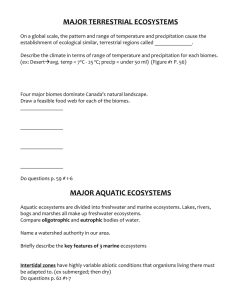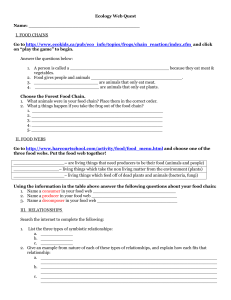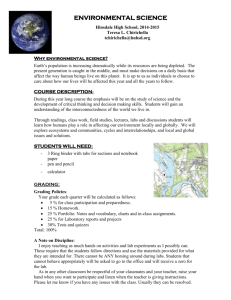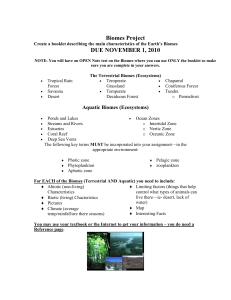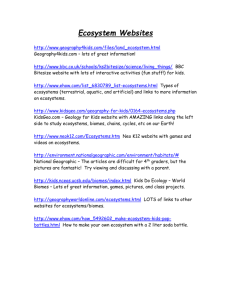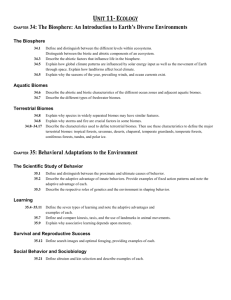Term Paper Helpful Sources - UW Faculty Web Server
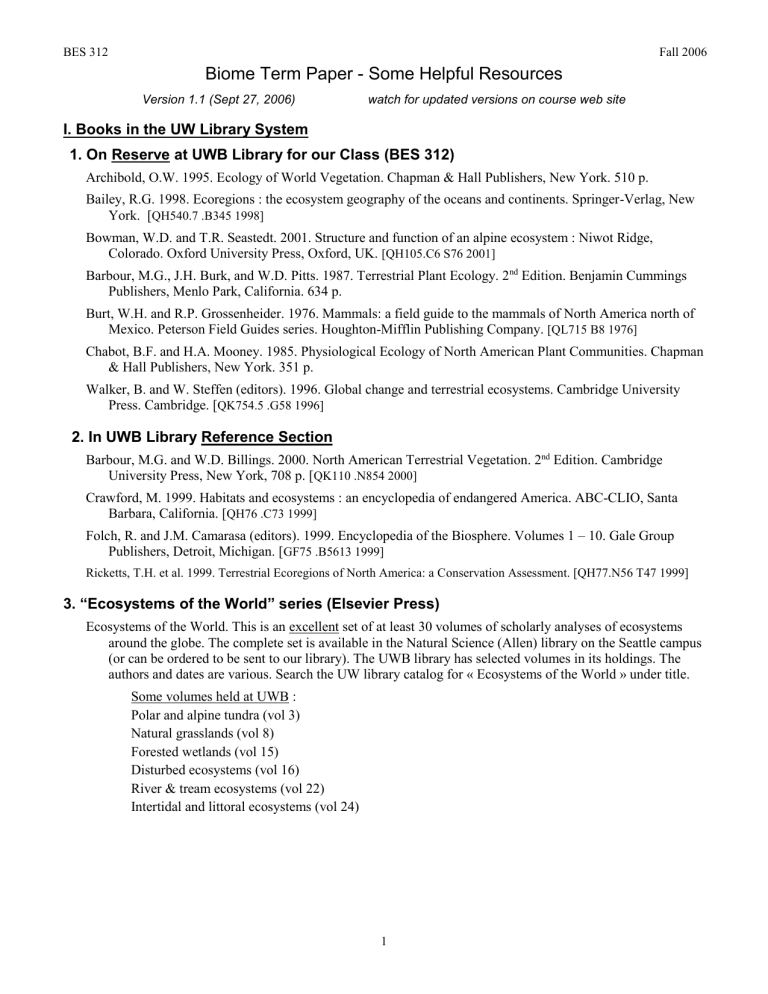
BES 312
Biome Term Paper - Some Helpful Resources
Fall 2006
Version 1.1 (Sept 27, 2006) watch for updated versions on course web site
I. Books in the UW Library System
1. On Reserve at UWB Library for our Class (BES 312)
Archibold, O.W. 1995. Ecology of World Vegetation. Chapman & Hall Publishers, New York. 510 p.
Bailey, R.G. 1998. Ecoregions : the ecosystem geography of the oceans and continents. Springer-Verlag, New
York. [ QH540.7 .B345 1998]
Bowman, W.D. and T.R. Seastedt. 2001. Structure and function of an alpine ecosystem : Niwot Ridge,
Colorado. Oxford University Press, Oxford, UK. [QH105.C6 S76 2001]
Barbour, M.G., J.H. Burk, and W.D. Pitts. 1987. Terrestrial Plant Ecology. 2 nd Edition. Benjamin Cummings
Publishers, Menlo Park, California. 634 p.
Burt, W.H. and R.P. Grossenheider. 1976. Mammals: a field guide to the mammals of North America north of
Mexico. Peterson Field Guides series. Houghton-Mifflin Publishing Company. [QL715 B8 1976]
Chabot, B.F. and H.A. Mooney. 1985. Physiological Ecology of North American Plant Communities. Chapman
& Hall Publishers, New York. 351 p.
Walker, B. and W. Steffen (editors). 1996. Global change and terrestrial ecosystems. Cambridge University
Press. Cambridge. [ QK754.5 .G58 1996]
2. In UWB Library Reference Section
Barbour, M.G. and W.D. Billings. 2000. North American Terrestrial Vegetation. 2 nd Edition. Cambridge
University Press, New York, 708 p. [ QK110 .N854 2000]
Crawford, M. 1999. Habitats and ecosystems : an encyclopedia of endangered America. ABC-CLIO, Santa
Barbara, California. [ QH76 .C73 1999]
Folch, R. and J.M. Camarasa (editors). 1999. Encyclopedia of the Biosphere. Volumes 1 – 10. Gale Group
Publishers, Detroit, Michigan. [ GF75 .B5613 1999]
Ricketts, T.H. et al. 1999. Terrestrial Ecoregions of North America: a Conservation Assessment. [QH77.N56 T47 1999]
3. “Ecosystems of the World” series (Elsevier Press)
Ecosystems of the World. This is an excellent set of at least 30 volumes of scholarly analyses of ecosystems around the globe. The complete set is available in the Natural Science (Allen) library on the Seattle campus
(or can be ordered to be sent to our library). The UWB library has selected volumes in its holdings. The authors and dates are various. Search the UW library catalog for « Ecosystems of the World » under title.
Some volumes held at UWB :
Polar and alpine tundra (vol 3)
Natural grasslands (vol 8)
Forested wetlands (vol 15)
Disturbed ecosystems (vol 16)
River & tream ecosystems (vol 22)
Intertidal and littoral ecosystems (vol 24)
1
BES 312 Fall 2006
4. Web Resources – some general resources
Biomes of the World – College of the Siskiyous, Geography Department
(http://www.snowcrest.net/geography/slides/biomes/)
Ecological Subregions of the United States, U.S. Forest Service
(http://www.fs.fed.us/land/pubs/ecoregions/index.html)
Major Biomes of the World – Radford University Geography Department Project
(http://www.runet.edu/%7Eswoodwar/CLASSES/GEOG235/biomes/main.html)
Status and Trends of the Nation’s Biological Resources (US)
(http://biology.usgs.gov/s+t/SNT/index.htm)
Terrestrial Biomes – Ralph Taggart, Dept of Plant Biology, Michigan State Univ.
(http://taggart.glg.msu.edu/bs110/biomes.htm)
The World’s Biomes – Biology Department University of California, Berkeley
(http://www.ucmp.berkeley.edu/glossary/gloss5/biome/)
University of Washington Library Links for Maps and GIS databases
(http://www.lib.washington.edu/subject/USMaps/dr/elnum.html)
University of Washington Atmospheric Sciences department links to Washington weather and climate info
(http://www.atmos.washington.edu/data/)
US Department of Agriculture Electronic Photo Archive
(http://www.usda.gov/oc/photo/opcphsea.htm)
USDA-NRCS National Soil Survey Center
(http://www.statlab.iastate.edu/soils/nssc/)
World Resources Institute
(http://www.wri.org/wri/index.html)
World Wildlife Fund – International
(http://www.wwf.org)
World Wildlife Fund – United States
(http://www.worldwildlife.org/)
Links to various federal agencies and ecological resources at the bottom of my home page: http://faculty.washington.edu/wgold/. Although this has a Pacific Northwest focus, some links here may be generally useful.
Look into web sites for federal and state lands of the region you are studying. For example, if you were studying the Great Basin you might wish to explore state land management agencies in Utah, Nevada,
Idaho, etc. as well as the US Bureau of Land Management.
4. Library / Search Resources
Rob Estes, science librarian can assist you with this search (or any other reference librarian for that matter).
Use the UW Library Catalog search utility or many of the CD-ROM databases available (e.g., BIOSIS, etc.).
See our knowledgeable librarians for help with this.
Science Citation Index : a web-based search service for scientific journal articles (usable on UW computers).
SCI can be used to search for articles based on keywords, titles and authors' names. One of its most powerful features is its ability to search for articles in which a certain author has been cited. Thus, if you know that "R. Daubenmire" wrote a lot of stuff about the Palouse Prairie, you can search for articles that cite his works as a reference.
To use it, from the Library Gateway choose "databases & catalogs". Click on "S-T". Scroll down to
"Science Citation Index - UW Restricted". This leads you into the search utility.
2
